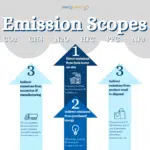
Table of Contents
- Why Carbon Accounting is Important for Businesses
- What is Carbon Accounting?
- Defining GHG Emissions
- How To Get Started with Carbon Accounting
- What are the benefits of measuring GHG emissions?
- How CPP Sustainable Investing Works
- ESG reporting frameworks: SASB, GRI, SBTi
- What is the GHG protocol?
- GHG data verification
- The difference between GHG verification, validation, assurance, and audit
Why Carbon Accounting is Important for Businesses
Carbon accounting, or Greenhouse Gas (GHG) Assessment, refers to the process of quantifying the amount of carbon dioxide and other greenhouse gases that commercial or national institutions emit as part of their operations.
Carbon accounting assists companies in understanding their impact on global warming and climate change, as well as assisting them in setting goals to reduce emissions. This encourages climate action and corporate sustainability in meeting their net-zero emission targets. Additionally, carbon accounting helps in planning an emission reduction strategy by making clear which areas of a business’ operations are the primary sources of emissions.
What is Carbon Accounting?
Enterprise Carbon Accounting, or Corporate Carbon Footprint, is a quick and cost-effective approach to help businesses gather, summarize and report enterprise and supply chain greenhouse gas inventories. Greenhouse gas inventories are lists of emissions and their sources, which are quantified using standardized methods. Carbon accounting and monitoring will yield different results for each business.
To be successful, your Enterprise Carbon Account requires the following characteristics:
- Comprehensive: Incorporates scope 1, 2, and 3 emissions.
- Periodic: Allows for regular updates and comparisons across reporting periods.
- Auditable: Transactions are traceable and allow for independent reviews for compliance.
- Flexible: Uses data from various approaches to life cycle analysis.
- Standardized: Accommodates existing accepted standards and emergency standards.
- Efficient: Delivers data in a prompt timeframe.
Defining GHG Emissions
GHG emissions are categorized into 3 scopes:
Scope 1
Also known as direct emissions, these GHG emissions are produced directly by companies through burning purchased fuel on-site, such as natural gas, diesel and propane. Purchasing carbon offsets helps mitigate Scope 1 emissions.
Scope 1 emissions can be further divided into 4 categories:
- Stationary Combustion: Power plants, combined heat and power plants, industrial combustion plants, district heating plants and small plants.
- Mobile Combustion: Emissions from the combustion of fuels in company-owned or controlled mobile combustion sources during the transportation of materials, waste, products and employees.
- Fugitive Emissions: Unintentional and undesirable leakages and discharges of gases or vapours from pressure-containing equipment or facilities. They may also come from components within industrial plants such as pumps, storage tanks or compressors.
- Process Emissions: Emissions from the chemical transformation of raw materials and fugitive emissions.
Scope 2
Scope 2 emissions are indirect GHG emissions that are associated with the purchase of secondary sources of energy, such as electricity, steam, heating or cooling. These emissions are accounted for in an organization’s greenhouse gas inventory since they are a result of the organization’s energy use.
The Greenhouse Gas Protocol provides guidance for various scenarios and circumstances to assist with identifying Scope 2 emissions to avoid double-counting emissions between Scope 1 and Scope 2 emissions.
For example, if an instance of consumed electricity comes from owned or operated equipment from the same entity, it would not be reported as a Scope 2 emission since the emissions from power generation should be reported in Scope 1.
Scope 3
Scope 3 emissions, otherwise known as value chain emissions, are those that the organization is indirectly responsible for upstream and downstream of its value chain. This includes emissions related to buying products from suppliers and those associated with customers using products.
Overall, Scope 3 emissions (also known as value chain emissions) often represent the majority of an organization’s total GHG emissions according to the United States’ Environmental Protection Agency.
Below is a list of emission factors relevant to Scope 3 emissions as provided by the GHG Emissions Factors Hub:
- Upstream transportation and distribution.
- Downstream transportation and distribution.
- Waste generated in operations.
- End-of-life treatment of sold products.
- Business travel.
- Employee commuting.

How To Get Started with Carbon Accounting
For businesses who are new to developing a sustainability strategy, clarifying the sources and quantity of your emissions and pollution will give you insight into the most productive use of resources to meet your environmental goals. Our team assists in quantifying and reporting emissions data to help you get started.
Our Carbon Management Services
After consulting with us, we’ll work with you to define the boundaries of the emissions data to determine what’s needed for your selected framework. From there, we collect the data and quantify the emission’s sources and scopes. Then, we assist you in reporting data, so you gain a head start on hitting your net-zero targets.
You can reach us via web form or calling us at 1-780-628-1861.
What are the benefits of measuring GHG emissions?
Measuring greenhouse gas emissions is the first step to managing them. After a company audits its own greenhouse gas emissions, it can examine the sources of waste or inefficiencies. In the long term, greenhouse gas accounting benefits the environment through lowered emissions and a business through diminished financial costs.
Tracking your GHG Emissions
If your business is ready to work towards being carbon neutral and reducing its environmental impact but you’re not sure where to start, our team at EnergyRates.ca can help guide you through the process, including joining other businesses in energy aggregation, purchasing RECs and Carbon Offsets, or reducing scope 2 emissions via power purchasing agreements. Our team can even help you look at a greener energy plan that’s suitable for your organization’s needs.
To get started, you can contact our team via this form or call 1-780-628-1861.
How CPP Sustainable Investing Works
The Canadian Pension Plan is a retirement pension that allows Canadians to replace part of their income when they plan to retire. The government takes CPP contributions and makes investments to give Canadians the pension they need to retire with minimal risk.
Building on the principles of ESG, the CPP is moving towards prioritizing sustainable investments. This has two primary benefits: it helps Canadians approach net-zero emissions, but also offers more perceived stability of the investments “to maximize long-term investment returns without undue risk of loss” (Newswire).
The CPP has aligned with the Sustainability Accounting Standards Board (SASB) and the Task Force of Climate-related Financial Disclosures (TCFD) to disclose the relevant ESG information on the companies the CPP invests in.
ESG reporting frameworks: SASB, GRI, SBTi
How the SASB works
The Sustainability Accounting Standards Board is an ESG guidance framework that sets standards for the disclosure of sustainability information that is financially material (or relevant to a company’s financial performance). The SASB standards differ across 77 industry sectors, with the understanding that these standards should create value for the enterprise and that different industries will have environmental, social and governmental impacts.
The SASB has many different tools for ensuring effective ESG reporting, including their own Materiality Finder tool that generates a“visual representation of their portfolio’s exposure to specific sustainability risks and opportunities.”
The SASB identifies five dimensions of sustainability that it reports on: environmental, social capital, human capital, business model and innovation, and leadership and governance. SASB has downloadable standards for over 170 countries.
SASB standards are maintained by the Value Reporting Foundation, “a global non-profit organization that offers a comprehensive suite of resources designed to help businesses and investors develop a shared understanding of enterprise value.”
How the Global Reporting Initiative (GRI) works
The Global Reporting Initiative is a non-profit organization that seeks to establish a framework for communicating about and reporting on the environmental impacts of companies.
The GRI’s modus operandi is stated on its website: “GRI (Global Reporting Initiative) is the independent, international organization that helps businesses and other organizations take responsibility for their impacts, by providing them with the global common language to communicate those impacts.”
The GRI’s main goal is to develop a framework of communication that allows for transparent comprehensive disclosures of ESG impacts a company may make. For this reason, GRI is not only compatible with other frameworks that look at other factors but synergistic with some including the SASB.
How the SBTi works
The Science Based Target initiative is an ESG framework that aims to illustrate the path towards environmental conservatism with scientifically derived targets that satisfy the guidelines set by the Paris Agreement.
The SBTi introduced the first corporate Net-Zero Standard, with guidance, recommendations and criteria that companies require to reach net-zero emissions.
The SBTi is a result of collaboration between CDP, WRI, WWF & UN Global Compact.
What is the GHG protocol?
The Greenhouse Gas Protocol provides the global standard for companies and organizations to measure and manage their GHG emissions. As such, it provides GHG accounting and reporting standards, sector guidance, calculation tools and training for businesses and national governments.
GHG data verification
Third-party verification is conducted by independent organizations accredited to perform GHG verification. It is the part of the process where a company’s GHG data is reviewed by certified verifiers, after being previously calculated and managed by a carbon accountant and/or sustainability expert. This is when all your GHG performance, both sustainability measures and emissions calculations, is verified by a third party for accuracy and transparency.
Such verification is required by the CDP (formerly known as Carbon Disclosure Project) for companies to disclose their environmental information and receive a score and the CPD certification. A CDP score is a summary of a company’s environmental performance.
As climate action gains traction in the corporate world, multiple stakeholders may request your carbon disclosure and CDP score, including investors, large purchasers, and supply chain members. This data can also be included in major investor platforms and ESG ranking reports. Currently, more than 18,000 companies have responded to the CDP questionnaire.
In the third-party verification process, information is verified by external auditors under internationally recognized standards, including ISO or ISAE. Due to the variety of industries and locations, there are multiple ways a carbon accounting verifier can review a company’s GHG data. So, instead of a one-size-fits-all approach, the CDP provides organizations with a list of standards that suit CDP reporting, as well as the ones that don’t fit.
Accredited verification solutions providers can not only verify your GHG data and environmental work but also provide certification and assurance of sustainability and climate data.
What are the benefits of environmental and carbon disclosure?
Reporting your environmental data as a company is a growing demand in today’s world. This can generate new business opportunities, uncover potential gaps and risks, improve your business’s reputation and marketing strategies, and help you meet regulatory requirements.
As listed on the CDP website, the criteria for third-party verification standards are:
- Relevance: The standard should specify that it relates to a 3rd party audit or verification process; for a program related standard, 3rd party verification should be specified as part of the program compliance.
- The standard should include a statement regarding competency of verifiers; where it is a program and verification parties are stipulated, competency is assumed to be determined by the 2nd party and therefore need not be explicit in the standard.
- Independence: The standard should contain a requirement that ensures that impartiality is maintained in cases where the same external organization compiles and verifies a responding company’s inventory.
- Terminology: The standard should specify the meaning of any terms used for the level of the finding (e.g. limited assurance; reasonable assurance).
- Methodology: The standard should describe a methodology for the verification that includes the verification of the process and/or system controls and the data.
- Availability: The standard should be available for scrutiny.
Verification standards accepted by the CDP
- AA1000AS
- ABNT NBR ISO 14064-3:2007 (Associação Brasileira de Normas Técnicas)
- Advanced technologies promotion Subsidy Scheme with Emission reduction Target (ASSET)
- Airport Carbon Accreditation (ACA) des Airports Council International Europe
- Alberta Specified Gas Emitters Regulation
- ASAE3000
- Attestation Standards established by the American Institute of Certified Public Accountants/AICPA.
- Australia National Greenhouse and Energy Regulations 2 (NGER Act)
- California Mandatory GHG Reporting Regulations (also known as Californian Air Resources Board regulations)
- Canadian Institute of Chartered Accountants (CICA) Handbook: Assurance Section 5025
- Carbon Trust Standard
- Chicago Climate Exchange verification standard
- The Climate Registry’s General Verification Protocol (also known as California Climate Action Registry (CCAR))
- Compagnie Nationale des Commissaires aux Comptes (CNCC)
- Corporate GHG Verification Guidelines from ERT
- DNV Verisustain Protocol/ Verification Protocol for Sustainability Reporting
- Earthcheck Certified
- ERM GHG Performance Data Assurance Methodology
- IDW PS 821: IDW Prüfungsstandard: Grundsätze ordnungsmäßiger Prüfung oder prüferischer Durchsicht von Berichtenim Bereich der Nachhaltigkeit
- IDW AsS 821: IDW Assurance Standard: Generally Accepted Assurance Principles for the Audit or Review of Reports on Sustainability Issues
- ISAE 3000
- Dutch Standard 3000A
- ISAE 3410, Assurance Engagements on Greenhouse Gas Statements
- ISO 14064-1
- ISO 14064-3
- JVETS (Japanese Voluntary Emissions Trading Scheme) Guideline for verification
- Korean GHG and energy target management system
- NMX-SAA-14064-3-IMNC: Instituto Mexicano de Normalización y Certificación A.C
- RevR 6 Bestyrkande av hållbarhetsredovisning (RevR 6 Assurance of Sustainability)
- RevR6 Procedure for assurance of sustainability report from Far, the Swedish auditors professional body
- Saitama Prefecture Target-Setting Emissions Trading Program
- Standard 3810N Assurance engagements relating to sustainability reports of the Royal Netherlands Institute of Registered Accountants
- SGS Sustainability Report Assurance
- Spanish Institute of Registered Auditors (ICJCE)
- SSAE 3000
- State of Israel Ministry of Environmental Protection, VERIFICATION OF GREENHOUSE GAS EMISSIONS AND EMISSIONS REDUCTION IN ISRAEL GUIDANCE DOCUMENT FOR CONDUCTING VERIFICATIONS, Process A.
- Swiss Climate CO2 label
- Thai Greenhouse Gas Management Organisation (TGO) Greenhouse Gas (GHG) Verification Protocol
- Toitū Envirocare’s carbonreduce certification standard
- Toitū climate positive
- Toitū net carbonzero
- Tokyo Emissions Trading Scheme
- Verification under the EU Emissions Trading Scheme (EU ETS) Directive and EU ETS related national implementation laws
What’s the proportion of emissions data that needs to be verified under the CPD requirements?
As published on the CDP website, to be awarded Leadership points for Scope 1 and Scope 2 Climate Change verification questions in 2023, 100% of each scope 1 and 2 of emissions must be verified.
To be awarded Leadership points for Scope 3 Climate Change verification question in 2023, at least 70% of scope 3 of emissions must be verified.
Verification of 100% of scope 1 and 2 emissions and at least 70% of a minimum of one scope 3 category emissions are required for a company to be eligible to receive an ‘A’ score for the Climate Change programme.
For more information, check the CPD’s FAQ document.
The difference between GHG verification, validation, assurance, and audit
Audit
Third-party auditing of carbon emissions data is the process of having an independent organization assuming responsibility for the evaluation of your company’s environmental performance.
Verification
The process of having a company’s emissions data evaluated. This includes independent verification of not only the emissions for a given year but also of the carbon accounting work associated with it, such as calculations and emission factors.
Validation
This is also an independent analysis that generates, amongst other statements, roadmaps to reduce the potential errors, inaccuracies, and limitations related to a company’s emissions tracking and reporting mechanisms. The focus is on the future and on the measures that guarantee that the company will meet the expected goals.
Assurance
Assurance services exist to provide additional transparency and reliability for stakeholders. In summary, it confirms that the GHG data or sustainability measures conducted by another party, such as verification and validation, are accurate and under the expected standards.
Assurance levels: Limited assurance vs Reasonable assurance
Limited Assurance offers a lower level of assurance and can be considered less rigorous, meaning less evidence required and a smaller sample for examining data. It also assumes that the data management setup is reliable, whereas Reasonable Assurance requires more quantitative and qualitative evidence, uses larger sample sizes to audit emission sources, and reviews the data management system without reliability assumptions.
If you’d like to learn more about calculating your emissions or building an effective ESG strategy, our experts are here to help. Give us a call today or fill out the form on this page.











